Large Scale Shrub Biomass Estimates for Multiple Purposes
Abstract
1. Introduction
2. Materials and Methods
2.1. Study area Characteristics
2.2. Data Sources
2.3. Sampling Plots
3. Results
3.1. Shrubland Characterization
3.2. Allometric Model for Shrub Biomass Estimation
4. Discussion
4.1. Shrubland Characterization
4.2. Allometric Model for Shrub Biomass Estimation
5. Conclusions
Author Contributions
Funding
Conflicts of Interest
References
- Caetano, M.; Igreja, C.; Marcelino, F.; Costa, H. Estatísticas e dinâmicas territoriais multiescala de Portugal Continental 1995-2007-2010 com base na Carta de Uso e Ocupação do Solo (COS). Direcção Geral Territ. 2017, 149. [Google Scholar]
- Serra, P.; Pons, X.; Saurí, D. Land-cover and land-use change in a Mediterranean landscape: A spatial analysis of driving forces integrating biophysical and human factors. Appl. Geogr. 2008, 28, 189–209. [Google Scholar] [CrossRef]
- Mateus, P.; Fernandes, P.M.P. The Portuguese Forest Based Chains: Sector Analyses. In Forest Context and Policies in Portugal, Present and Future Challenges, World Forests; Reboredo, F., Ed.; Springer: Cham, Switzerland, 2014; Volume 19, ISBN 9783319084541. [Google Scholar]
- Ursino, N.; Romano, N. Wild forest fire regime following land abandonment in the Mediterranean region. Geophys. Res. Lett. 2014, 41, 8359–8368. [Google Scholar] [CrossRef]
- ICNF. I F N 6—Áreas dos Usos do Solo e das Espécies Florestais de Portugal Continental 1995-2005-2010; Preliminary Report. 2013. Available online: http://www2.icnf.pt/portal/florestas/ifn/resource/ficheiros/ifn/ifn6-res-prelimv1-1 (accessed on 27 March 2019).
- Hosseini, M.; Geissen, V.; González-Pelayo, O.; Serpa, D.; Machado, A.I.; Ritsema, C.; Keizer, J.J. Effects of fire occurrence and recurrence on nitrogen and phosphorus losses by overland flow in maritime pine plantations in north-central Portugal. Geoderma 2017, 289, 97–106. [Google Scholar] [CrossRef]
- Bento-Gonçalves, A.J.; Vieira, A.V.; Costa, M.R.M. Perspectives, Issues and Challenges of the 21st Century; Nova Science Publishers: Hauppauge, NY, USA, 2018. [Google Scholar]
- Huff, S.; Poudel, K.P.; Ritchie, M.; Temesgen, H. Quantifying aboveground biomass for common shrubs in northeastern California using nonlinear mixed effect models. Forest Ecol. Manag. 2018, 424, 154–163. [Google Scholar] [CrossRef]
- Imeson, A. Desertification, Land Degradation and Sustainability; John Wiley & Sons: West Sussex, UK, 2012; ISBN 1119978483. [Google Scholar]
- Cerdá, A.; Doerr, S.H. Influence of vegetation recovery on soil hydrology and erodibility following fire: An 11-year investigation. Int. J. Wildland Fire 2005, 14, 423–437. [Google Scholar] [CrossRef]
- Bochet, E.; Poesen, J.; Rubio, J.L. Runoff and soil loss under individual plants of a semi-arid Mediterranean shrubland: Influence of plant morphology and rainfall intensity. Earth Surf. Process. Landf. 2006, 31, 536–549. [Google Scholar] [CrossRef]
- Gómez-Aparicio, L.; Zamora, R.; Gómez, J.M.; Hódar, J.A.; Castro, J.; Baraza, E. Applying plant facilitation to forest restoration: A meta-analysis of the use of shrubs as nurse plants. Ecol. Appl. 2004, 14, 1128–1138. [Google Scholar] [CrossRef]
- Mangas, J.G.; Lozano, J.; Cabezas-Díaz, S.; Virgós, E. The priority value of scrubland habitats for carnivore conservation in Mediterranean ecosystems. Biodivers. Conserv. 2008, 17, 43–51. [Google Scholar] [CrossRef]
- Zuazo, V.H.D.; Pleguezuelo, C.R.R. Soil-erosion and runoff prevention by plant covers. A review. Agron. Sustain. Dev. 2008, 28, 65–86. [Google Scholar] [CrossRef]
- Botelho, S.; Vegao, J.A.; Fernandescl, P.; Rego, F.M.C. Prescribed Fire Behavior and Fuel Consumption in Northern Portugal and Galiza Maritime Pine Stands. In Proceedings of the 2nd international Conference Forest Fire Research, Coimbra, Portugal, 21–24 November 1994. [Google Scholar]
- Rego, F.C.; Pereira, J.P.; Fernandes, P.M.; Almeida, A.F. Biomass and Aerial Structure Characteristics of Some Mediterranean Shrub Species. In Proceedings of the 2nd International Conference on Forest Fire Research B, Coimbra, Portugal, 21–24 November 1994; pp. 377–384. [Google Scholar]
- Fernandes, P.M.; Rego, F.C. Equations for Fuel Loading Estimation in Shrub Communities Dominated by Chamaespartium Tidentatum and Erica Umbellata. In Proceedings of the III International Conference on Forest Fire Research, Luso, Portugal, 16–20 November 1998; pp. 2553–2564. [Google Scholar]
- Molina, J.R.; García, J.P.; Fernández, J.J.; Rodríguez y Silva, F. Prescribed fire experiences on crop residue removal for biomass exploitations. Application to the maritime pine forests in the Mediterranean Basin. Sci. Total Environ. 2018, 612, 63–70. [Google Scholar] [CrossRef] [PubMed]
- Silva, T.P.; Pereira, J.M.; Paúl, J.C.; Santos, M.T.; Vasconcelos, M.J. Estimativa de Emissões Atmosféricas Originadas por Fogos Rurais em Portugal Estimate of Atmospheric Emissions Originated by Wildfires in Portugal. Silva Lusit. 2006, 14, 239–263. [Google Scholar]
- Viana, H. Modelling and Mapping Aboveground Biomass for energy Usage and Carbon Storage Assessment in Mediterranean Ecosystems. Ph.D. Thesis, Universidade de Trás os Montes e Alto Douro, Vila Real, Portugal, 2012. [Google Scholar]
- Cairns, M.A.; Lajtha, K.; Beedlow, P.A. Dissolved carbon and nitrogen losses from forests of the Oregon Cascades over a successional gradient. Plant Soil 2009, 318, 185–196. [Google Scholar] [CrossRef]
- Viana, H.; Fernandes, P.; Rocha, R.; Lopes, D.; Aranha, J. Alometria, Dinâmicas da Biomassa e do Carbono Fixado em Algumas Espécies Arbustivas de Portugal. In Proceedings of the 6º Congresso Florestal Nacional, Ponta Delgada, Portugal, 6–9 October 2009; pp. 244–252. [Google Scholar]
- Aranha, J.; Calvão, A.R.; Lopes, D.; Viana, H. Quantificação Da Biomassa Consumida Nos Últimos 20 Anos De Fogos Florestais No Norte Portugal. Rev. İnf. Ordem Eng. REGIÃO NORTE 2011, Info26, 44–49. [Google Scholar]
- Kazanis, D.; Xanthopoulos, G.; Arianoutsou, M. Understorey fuel load estimation along two post-fire chronosequences of Pinus halepensis Mill. forests in Central Greece. J. Forest Res. 2012, 17, 105–109. [Google Scholar] [CrossRef]
- Navarro Cerrillo, R.M.; Oyonarte, P.B. Estimation of above-ground biomass in shrubland ecosystems of southern Spain. Forest Syst. 2006, 15, 197–207. [Google Scholar] [CrossRef]
- Moreira, F.; Rego, F.C.; Ferreira, P.G. Temporal (1958–1995) pattern of change in a cultural landscape of northwestern Portugal: Implications for fire occurrence. Landsc. Ecol. 2001, 16, 557–567. [Google Scholar] [CrossRef]
- Ferreira Leite, F.; Bento Gonçalves, A.; Vieira, A. The recurrence interval of forest fires in Cabeço da Vaca (Cabreira Mountain-northwest of Portugal). Environ. Res. 2011, 111, 215–221. [Google Scholar] [CrossRef]
- Oliveira, S.L.J.; Pereira, J.M.C.; Carreiras, J.M.B. Fire frequency analysis in Portugal (1975–2005), using Landsat-based burnt area maps. Int. J. Wildland Fire 2011, 21, 48–60. [Google Scholar] [CrossRef]
- Pereira, M.G.; Aranha, J.; Amraoui, M. Land cover fire proneness in Europe. Forest Syst. 2014, 23, 598–610. [Google Scholar] [CrossRef]
- Fernandes, P.M.; Fernandes, M.M.; Loureiro, C. Post-fire live residuals of maritime pine plantations in Portugal: Structure, burn severity, and fire recurrence. Forest Ecol. Manag. 2015, 347, 170–179. [Google Scholar] [CrossRef]
- Moreno, J.; Fatela, F.; Moreno, F.; Leorri, E.; Taborda, R.; Trigo, R. Grape harvest dates as indicator of spring-summer mean maxima temperature variations in the Minho region (NW of Portugal) since the 19th century. Glob. Planet. Chang. 2016, 141, 39–53. [Google Scholar] [CrossRef]
- Alin, A. Multicollinearity. Wiley Interdiscip. Rev. Comput. Stat. 2010, 2, 370–374. [Google Scholar] [CrossRef]
- Dormann, C.F.; Elith, J.; Bacher, S.; Buchmann, C.; Carl, G.; Carré, G.; Marquéz, J.R.G.; Gruber, B.; Lafourcade, B.; Leitão, P.J.; et al. Collinearity: A review of methods to deal with it and a simulation study evaluating their performance. Ecography 2013, 36, 27–46. [Google Scholar] [CrossRef]
- Viana, H.; Cohen, W.B.; Lopes, D.; Aranha, J. Assessment of forest biomass for use as energy. GIS-based analysis of geographical availability and locations of wood-fired power plants in Portugal. Appl. Energy 2010, 87, 2551–2560. [Google Scholar] [CrossRef]
- Wijaya, A.; Kusnadi, S.; Gloaguen, R.; Heilmeier, H. Improved strategy for estimating stem volume and forest biomass using moderate resolution remote sensing data and GIS. J. Forest Res. 2010, 21, 1–12. [Google Scholar] [CrossRef]
- Deng, S.; Shi, Y.; Jin, Y.; Wang, L. A GIS-based approach for quantifying and mapping carbon sink and stock values of forest ecosystem: A case study. Energy Procedia 2011, 5, 1535–1545. [Google Scholar] [CrossRef]
- Singh, T.P.; Das, S. Predictive Analysis for Vegetation Biomass Assessment in Western Ghat Region (WG) Using Geospatial Techniques. J. Indian Soc. Remote Sens. 2014, 42, 549–557. [Google Scholar] [CrossRef]
- Botequim, B.; Zubizarreta-Gerendiain, A.; Garcia-Gonzalo, J.; Silva, A.; Marques, S.; Fernandes, P.M.; Pereira, J.M.C.; Tomé, M. A model of shrub biomass accumulation as a tool to support management of portuguese forests. iForest 2014, 8, 114–125. [Google Scholar] [CrossRef]
- Nguyen, H.K.; Nguyen, B.N. Mapping biomass and carbon stock of forest by remote sensing and GIS technology at Bach Ma National Park, Thua Thien Hue province. J. Vietnam Environ. 2016, 8, 80–87. [Google Scholar]
- Quinta-Nova, L.; Fernandez, P.; Pedro, N. GIS-Based Suitability Model for Assessment of Forest Biomass Energy Potential in a Region of Portugal. Earth Environ. Sci. 2017, 95, 042059. [Google Scholar] [CrossRef]
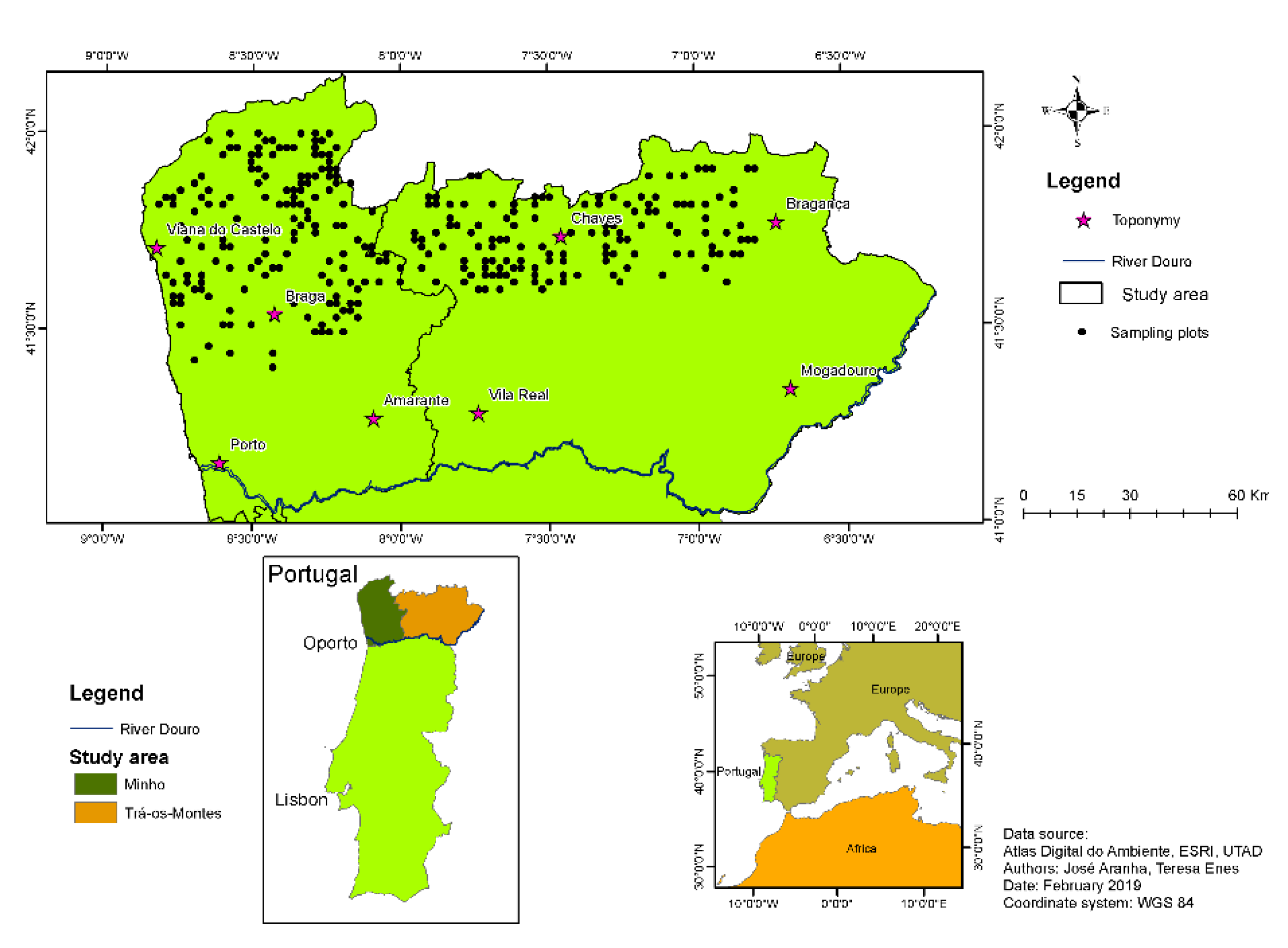
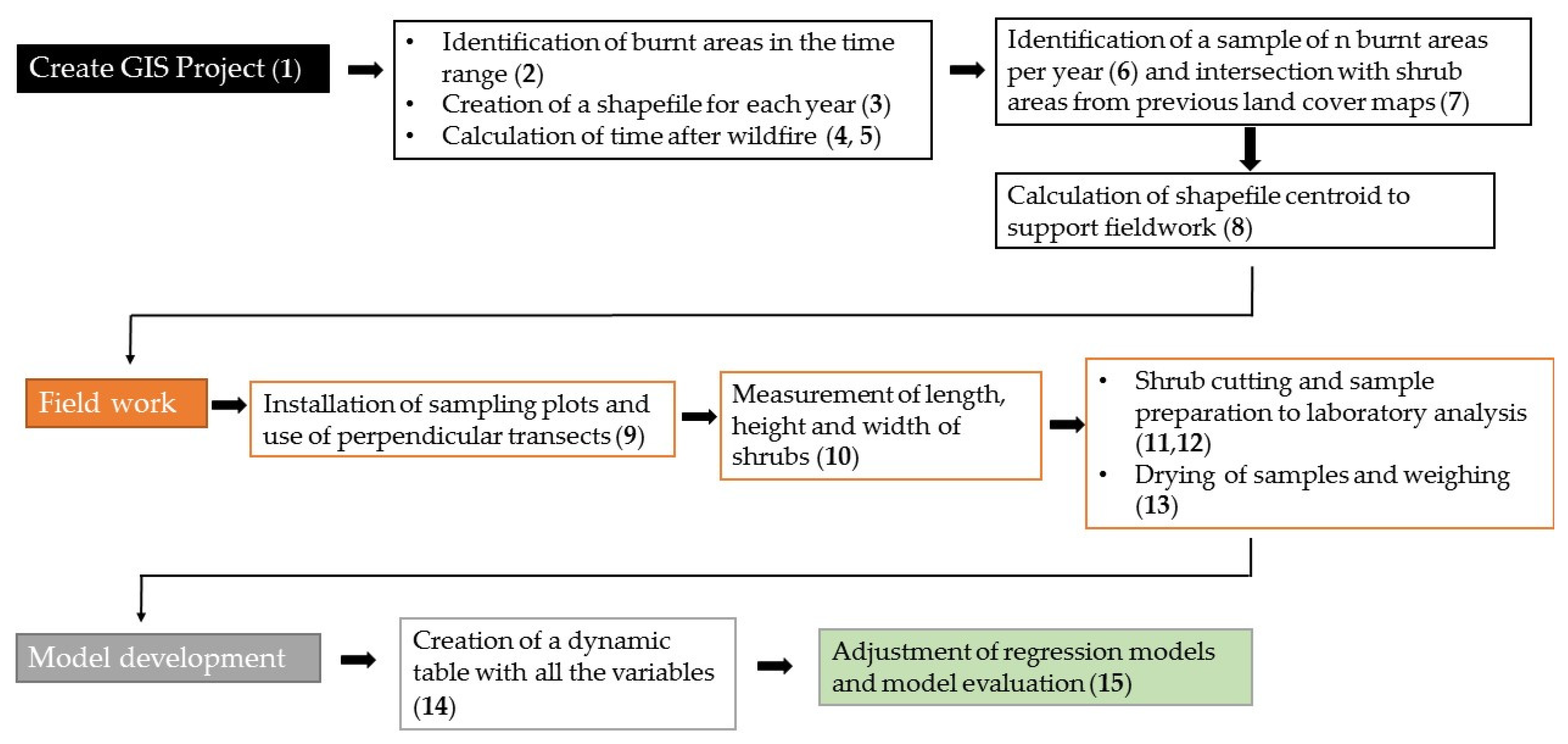
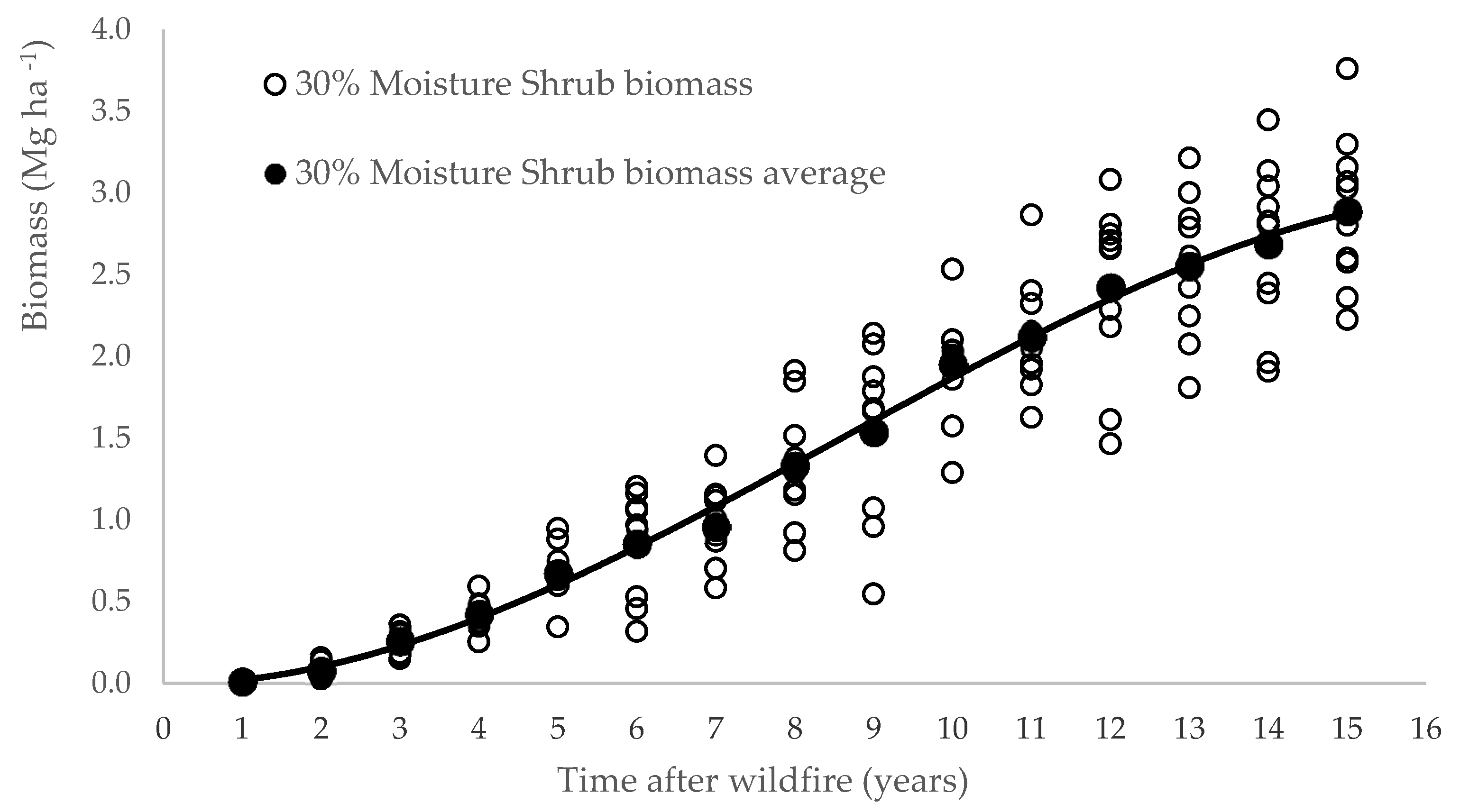
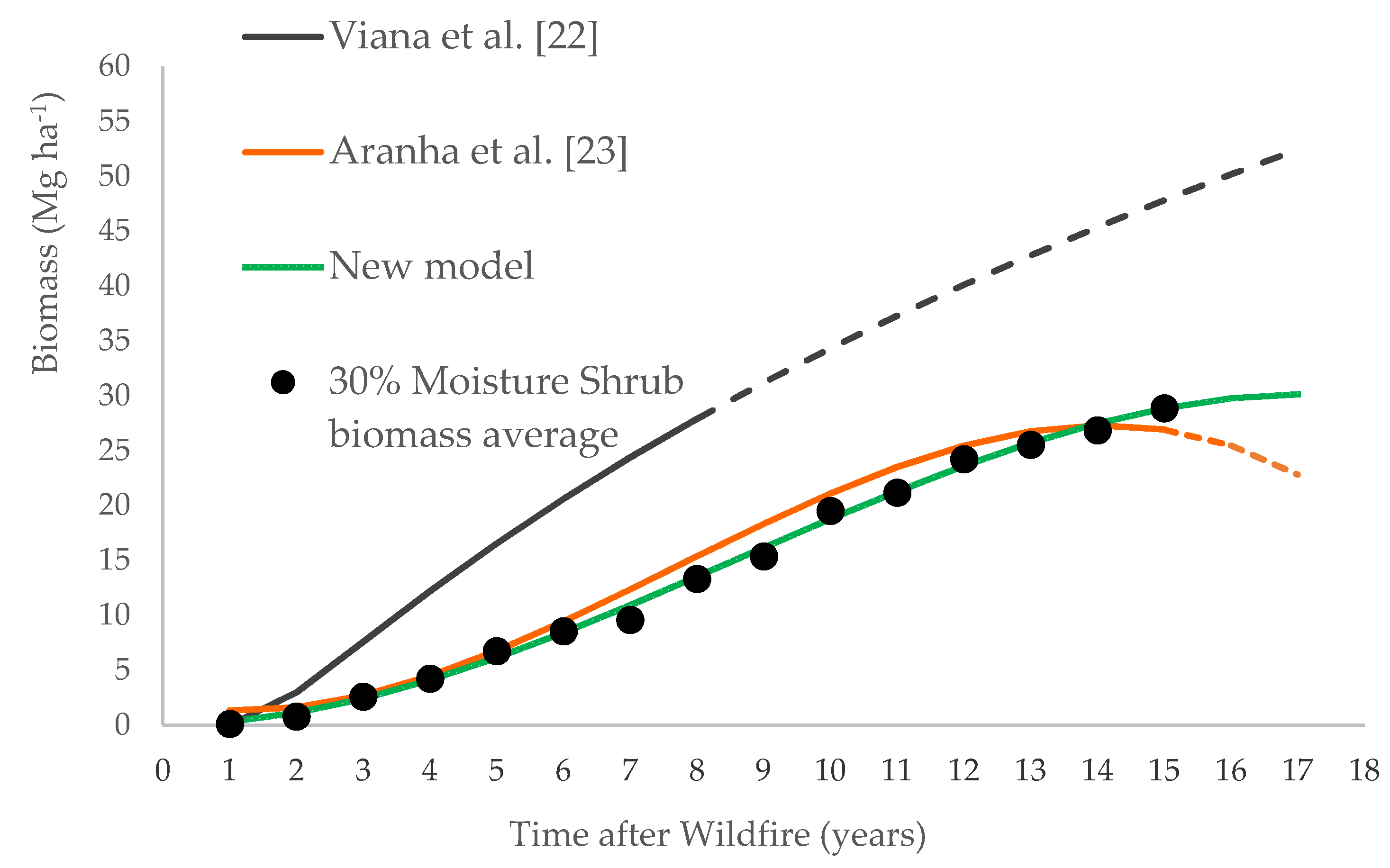
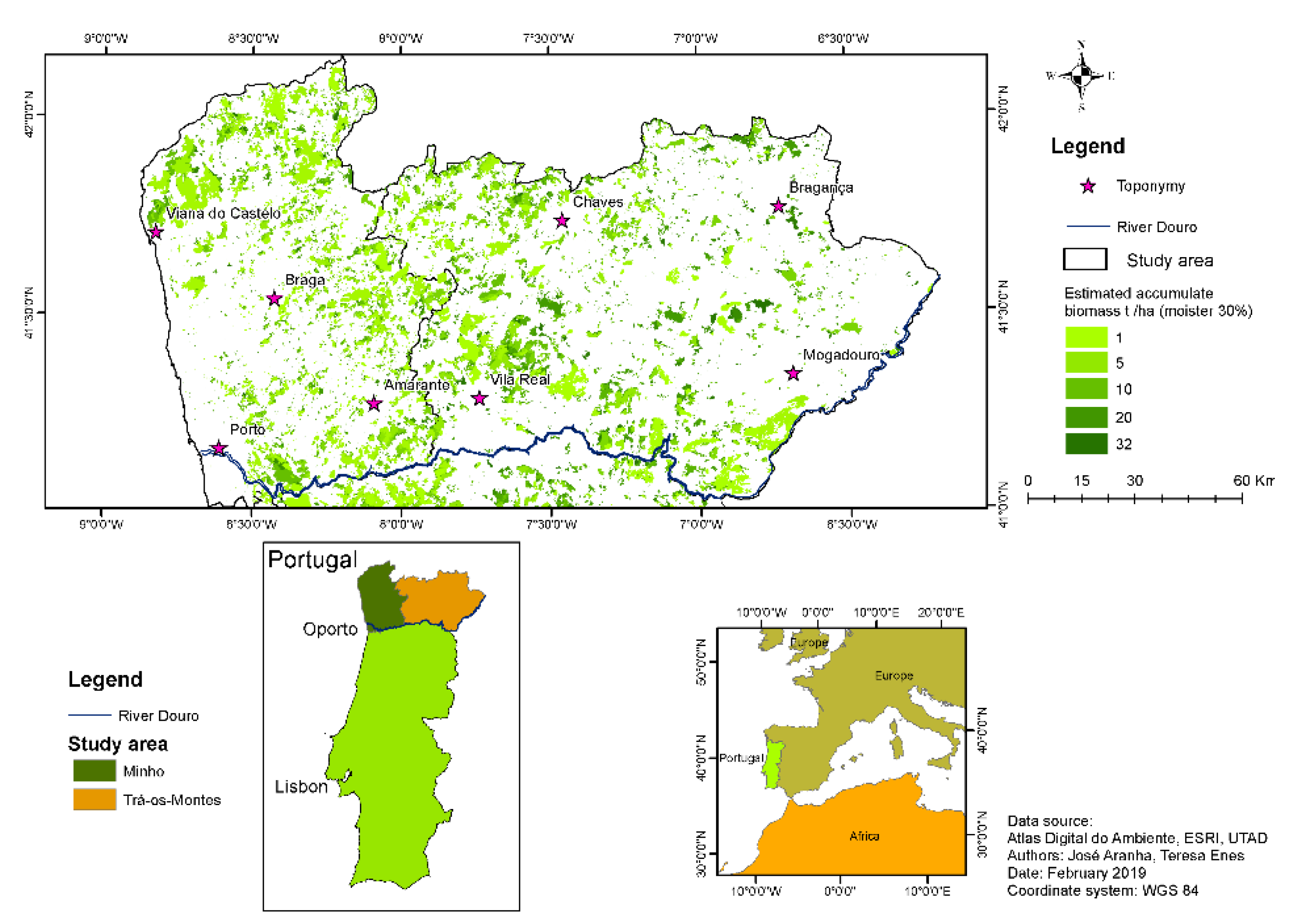
| Equation Number | Allometric Model (Shrub Species) | Reference |
|---|---|---|
| (1) (2) (3) (4) (5) (6) | − 184.11 t + 1034.2 (Erica sp.) (Cistus ladanifer L. and Erica sp.) (Cistus ladanifer L.) (Genista and Ulex) (Mancha) (Pistacia lentiscus L.) | [25] |
| (7) (8) (9) | [22] | |
| (10) (11) (12) | [23] | |
| (13) (14) (15) | [24] |
| Past Time after the Fire (Years) | 30% Moisture Shrub Biomass (Mg ha−1) | Canopy Cover (%) | ||
|---|---|---|---|---|
| Mean ± sd | Min − Max | Mean ± sd | Min − Max | |
| 1 | 0.119 ± 0.027 | 0.075 − 0.152 | 0.05 ± 0.04 | 0.01 − 0.10 |
| 2 | 0.773 ± 0.357 | 0.266 − 1.57 | 0.19 ± 0.04 | 0.12 − 0.23 |
| 3 | 2.595 ± 0.704 | 1.519 − 3.569 | 0.34 ± 0.07 | 0.24 − 0.44 |
| 4 | 4.247 ± 0.886 | 2.545 − 5.945 | 0.38 ± 0.02 | 0.35 − 0.41 |
| 5 | 6.743 ± 1.573 | 3.451 − 9.48 | 0.44 ± 0.01 | 0.42 − 0.45 |
| 6 | 8.556 ± 2.966 | 3.175 − 12.033 | 0.48 ± 0.02 | 0.46 − 0.50 |
| 7 | 9.586 ± 2.397 | 5.829 − 13.943 | 0.56 ± 0.02 | 0.54 − 0.59 |
| 8 | 13.783 ± 3.243 | 8.124 − 19.126 | 0.70 ± 0.06 | 0.64 − 0.77 |
| 9 | 15.368 ± 4.67 | 5.464 − 21.407 | 0.81 ± 0.04 | 0.77 − 0.87 |
| 10 | 19.368 ± 3.282 | 12.889 − 25.341 | 0.95 ± 0.03 | 0.92 − 1.00 |
| 11 | 21.183 ± 3.288 | 16.271 − 28.656 | 0.90 ± 0.1 | 0.80 − 1.00 |
| 12 | 25.285 ± 4.108 | 14.645 − 30.818 | 0.98 ± 0.04 | 0.90 − 1.00 |
| 13 | 25.544 ± 4.089 | 18.091 − 32.129 | 0.69 ± 0.17 | 0.60 − 100 |
| 14 | 26.871 ± 4.763 | 19.089 − 34.475 | 0.66 ± 0.23 | 0.50 − 1.00 |
| 15 | 28,877 ± 4.427 | 22.265 − 37596 | 0.78 ± 0.23 | 0.50 − 1.00 |
© 2020 by the authors. Licensee MDPI, Basel, Switzerland. This article is an open access article distributed under the terms and conditions of the Creative Commons Attribution (CC BY) license (http://creativecommons.org/licenses/by/4.0/).
Share and Cite
Enes, T.; Lousada, J.; Fonseca, T.; Viana, H.; Calvão, A.; Aranha, J. Large Scale Shrub Biomass Estimates for Multiple Purposes. Life 2020, 10, 33. https://doi.org/10.3390/life10040033
Enes T, Lousada J, Fonseca T, Viana H, Calvão A, Aranha J. Large Scale Shrub Biomass Estimates for Multiple Purposes. Life. 2020; 10(4):33. https://doi.org/10.3390/life10040033
Chicago/Turabian StyleEnes, Teresa, José Lousada, Teresa Fonseca, Hélder Viana, Ana Calvão, and José Aranha. 2020. "Large Scale Shrub Biomass Estimates for Multiple Purposes" Life 10, no. 4: 33. https://doi.org/10.3390/life10040033
APA StyleEnes, T., Lousada, J., Fonseca, T., Viana, H., Calvão, A., & Aranha, J. (2020). Large Scale Shrub Biomass Estimates for Multiple Purposes. Life, 10(4), 33. https://doi.org/10.3390/life10040033







